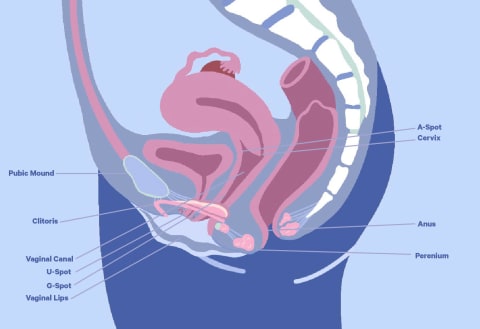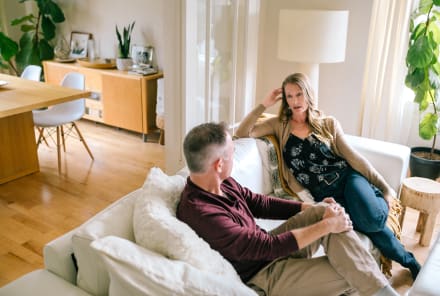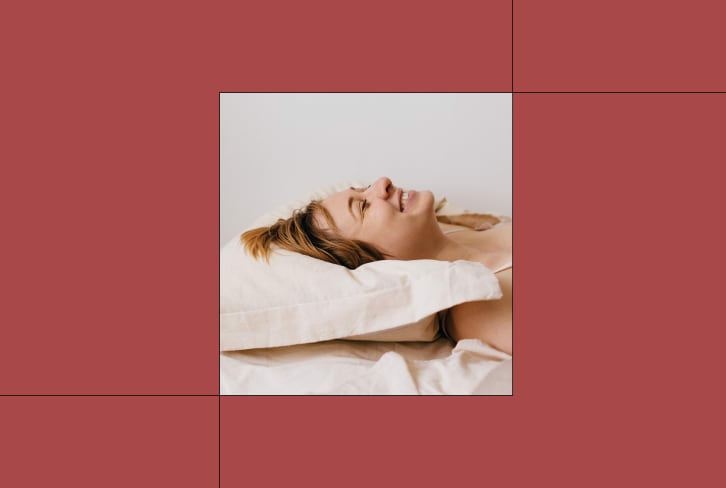Advertisement
What Is The A-Spot? Another Potentially Powerful Female Erogenous Zone


Many people still hold tightly to the belief that the so-called G-spot is the key to vaginal orgasms, but it's high time we start broadening our focus to other potential pleasure points. Take for example the G-spot's lesser-known cousin, the A-spot, which also offers a possible way for women to have mind-blowing orgasms.
What is the A-spot?
The A-spot is the anterior fornix erogenous zone, a sensitive area of tissue that exists at the ends of the vaginal canal, between the cervix and the bladder. It's located about an inch or two deeper than the G-spot, which can purportedly be found by making a come-hither motion with two fingers inside of the vagina.
"Some studies have suggested sensitivity in this area when stimulated, [which] can lead to improved lubrication and possibly more intense orgasm," Michael Ingber, M.D., a board-certified female pelvic medicine and sexual health specialist with the Center for Specialized Women's Health, tells mbg.
The A-spot has sometimes been referred to as the "female prostate," adds Alicia Sinclair, a certified sex educator and CEO of b-Vibe & Le Wand, "because of its precise location and ability to be stimulated similarly to the male prostate." (The prostate in men is sometimes referred to as the "male G-spot," interestingly, and typically stimulated anally.)

Research on the A-spot.
The A-spot was "discovered" in the 1990s via a study1 conducted by Malaysian physician Chua Chee Ann, M.D., in which he found that "stimulation of the AFE Zone, the erogenous centre in the inner half of the anterior wall of the vagina, results in rapid onset of reflex vaginal lubrication and build-up of erotic sensitivity, culminating in orgasms in some cases."
During the study, Chee Ann administered repeated, gentle strokes to the AFE zone to 271 women. About 40% of participants achieved orgasm—not bad considering the awkward circumstance of being sexually stimulated for a research experiment, right? But the more surprising and promising result: A full 78% of the participants experienced increased vaginal lubrication.
That's vital, considering a 2017 study2 found only about 18% of women can reach orgasm from penetration alone. It can feel good, but without catering to the clitoris, sex can feel like dinner without dessert—filling, but not as sweet as it could be.
Today, the scientific community is still at odds about whether there are actually any sort of special, highly sensitive spots within the anatomy of vagina owners other than the clitoris. Medically speaking, research on the G-spot's existence3 is conflicting and inconclusive, and experts argue about whether the vagina even has more concentrations of nerve tissue in particular areas over others, throwing the idea of G-spots and A-spots and any other spots into question.
The relationship between the A-spot, G-spot, and clitoris.
Some experts believe these supposedly sensitive areas like the G-spot and the A-spot may actually just be the back end of the clitoris itself, as the clitoris is a fairly long and expansive organ that internally wraps around a substantial part of the vagina and urethra. A 2014 study4 suggests the G-spot, in particular, may actually be the intersection of the clitoris, urethra, and the vagina, and when this intersection is stimulated, it can lead to intense orgasms and sometimes ejaculation.
To complicate things further, "It is unknown if, in many women, the A-spot is really the G-spot, just located a bit deeper inside than others," Ingber explains.
The fact that there's still so much mystery around the primary female pleasure organs is less a reflection on the complexity of the female body and much more a reflection of how little research, time, money, and energy has been invested into understanding female pleasure. But in the meantime, whether these spots are actually unique anatomical entities all their own or simply areas close enough to the inner shaft or wings of the clitoris to stimulate it, there's at least some evidence suggesting women can explore these areas as at least potential places to access pleasure.
How to find the A-spot.
Per Sinclair's instructions, you have to use the same hook motion that you would use to feel your G-spot. "Curve your fingers into a bit of a hook and reach in about 1 to 1½ inches inside the vagina, tilt them upward as if you were pointing toward your belly button."
When followed correctly, these instructions will lead you to hit the spongy tissue where the G-spot is believed to be located, and 1 to 2 inches inward from there is the A-spot. In order to stimulate the spot, move your fingers or have someone else move their fingers over the tissue in a windshield wiper motion. The key is to blend both movement and light pressure.
Anal sex may also be a good way to reach this deeper spot: "Anal orgasms can also happen through indirect stimulation of the erogenous zones within the vagina," Sinclair says.
The bottom line.
As we continue to uncover more information about female anatomy, researchers are also starting to study other possible erogenous zones that may be the key to unlocking all kinds of new sensations during sex. Chee Ann's foundational study suggests stimulating the A-spot might be a way to increase lubrication for people with vaginas.
Whether or not the A-spot is its own unique vaginal erogenous zone, if finding and stimulating this spot could intensify orgasms and provide a little more slip during sex, why not give it a try? And one other added bonus: Pleasure through the A-spot can take place in encounters outside of just P-in-V sex. That makes it an extremely accessible and fresh means for exploration.
Watch Next
Enjoy some of our favorite clips from classes
Enjoy some of our favorite clips from classes
What Is Meditation?
Mindfulness/Spirituality | Light Watkins
Box Breathing
Mindfulness/Spirituality | Gwen Dittmar
What Breathwork Can Address
Mindfulness/Spirituality | Gwen Dittmar
The 8 Limbs of Yoga - What is Asana?
Yoga | Caley Alyssa
Two Standing Postures to Open Up Tight Hips
Yoga | Caley Alyssa
How Plants Can Optimize Athletic Performance
Nutrition | Rich Roll
What to Eat Before a Workout
Nutrition | Rich Roll
How Ayurveda Helps Us Navigate Modern Life
Nutrition | Sahara Rose
Messages About Love & Relationships
Love & Relationships | Esther Perel
Love Languages
Love & Relationships | Esther Perel











